THE HAKA PARTY INCIDENT
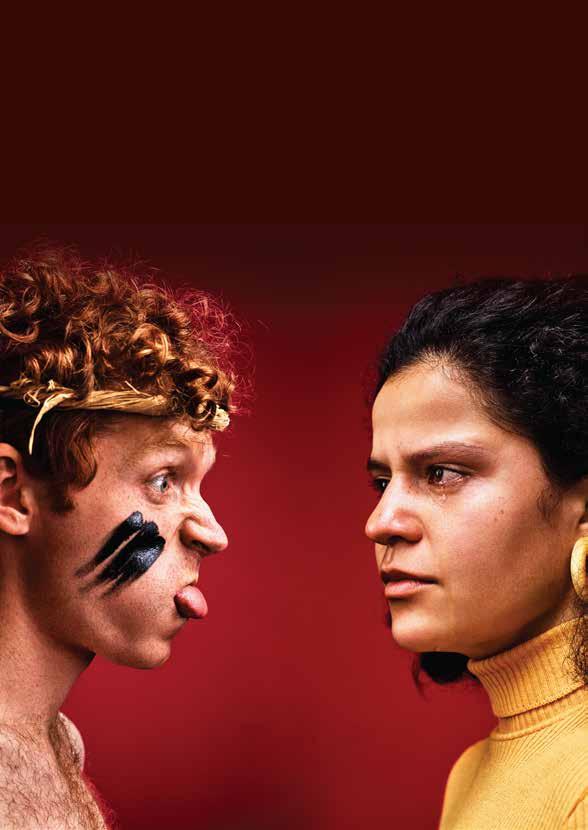 BY KATIE WOLFE
BY KATIE WOLFE
EDUCATION PACK
Thanks to our supporters
Contents
About the Play P.04
About the Playwright P.05
Historical Context P.07
About Verbatim Theatre P.12
Kōrero with the Director P.18
Kōrero with the Kapa/Cast P.22
Ngā Māngai P.32
Please note
• Photography or recording of any kind is strictly prohibited.
• Eating and drinking in the auditorium is strongly discouraged.
• Please make sure all cell phones are turned off.
• Please don’t bring school bags to the theatre.
Design P.33
Haka and Song P.46
Theatre Form P.50
Post-show Activities P.52
ATC Creative Learning P.54
Curriculum Links P.55
Venue: ASB Waterfront theatre, 138 Halsey Street, Auckland
School Matinee
Performances: Monday 29 March, Thursday 1, and Thursday 8 April at 11am
Running Time: 120 minutes, without an interval
Post-Show Takes place in the theatre immediately after the Forum: performance (15 - 20minutes)
Suitability: This production is suitable for Year Levels 11 - 13
Advisory: Contains strong language and descriptions of violence.
Please note that this production demonstrates historical examples of how haka and Te Reo Māori were incorrectly used and performed in the past.
Auckland Theatre Company receives principal and core funding from:
ATC Creative Learning also thanks the ATC Patrons, the ATC Supporting Acts and Foundation North for their ongoing generosity
Supported by our university partner - AUT
KAPA — ENSEMBLE
Roimata Fox, Aidan O’Malley, Neenah Dekkers-Reihana, Richard Te Are, Patrick Tafa, Lauren Gibson, Jarred Blakiston
NGĀ RINGATOI — CREATIVE
Writer and Director Katie Wolfe
Set Designer John Verryt
Lighting Designer Jo Kilgour
Sound Designer and Musical Director Kingsley Spargo
Costume Designer Alison Reid
Kaiako Kapa Haka/Kaitito Haka — Nīkau Balme
Assistant Director Whetu Silver
Assistant Writer — Catherine Grealish
NGĀ KAIWHAKAHAERE HANGA — PRODUCTION
Head of Production — Jess Leslie
Stage Manager — Catherine Grealish
Props Manager — Magdalena Hoult
Technical Manager — Ellis Thorpe
Assistant Stage Manager — Teiaro Taikato
Sound Operator — Thomas Lambert
Lighting and AV Operator — Zach Howells
Documentary Producer — Katie Wolfe
Documentary Crew — Dave Murray, Yves Simard, Lise Cook, Colleen Brennan, Jo Raj, Aroha Rawson, Kahukore Bell, Sean O’Connor
Verbatim Editor — Kingsley Spargo and Harley Campbell
Casting — Lynne Cardy
Teaching Artists — Acacia O'Connor, Tuakai Ohai and Ariaana Osborne
Audio Description — Nicola Owen from Audio Described Aotearoa
NZSL Interpreting and Signing — Kelly Hodgins from Platform Interpreting
Photographer — Andi Crown
Videographer — Lise Cook
Company Manager Interim — Eliza Josephson-Rutter
Production Runner — Rose Herda
Kaimanaaki — Aroha Rawson
Te Reo Translator — Amiria Stirling
Te Reo proofer (programme) — Clayton Cook
Te Reo and Tikanga Māori Consultants —
Ataahua Papa and Eynon Delamere
Te Ahurei Toi o Tāmaki / Auckland Arts Festival 2021
ATC CREATIVE LEARNING
Associate Director - 2021 — Lynne Cardy
Schools and youth coordinator — Billie Staples
Teaching Artists — Acacia O’Connor, Ariaana Osborne and Tuakoi Ohai
Education Pack Contributing Writers —
Shane Bosher, Katie Wolfe, Lynne Cardy.
Education Pack Editor — Lynne Cardy
Production designs courtesy of John Verryt and Alison Reid
Graphic Design — Wanda Tambrin and Nick Lurman
2 3
The Haka Party Incident was originally commissioned by Auckland Theatre Company, Auckland, New Zealand.
About the play
The Haka Party Incident resurrects the eventful day in 1979 when a group of University of Auckland engineering students rehearsing their annual tradition of a mock haka are confronted by the activist group, He Taua. Violence erupted that sent ripples through the nation and changed race relations in New Zealand forever.
Crafted by filmmaker and theatre director Katie Wolfe from interviews with people who were there, The Haka Party Incident combines verbatim theatre, kapa haka, sound and music to powerful effect.
About the playwright
Katie Wolfe Ngāti Mutunga, Ngāti Tama Writer and Director of The Haka Party Incident
Katie Wolfe is well known to audiences as a director and actor who works across theatre, film and television in both drama and documentary.
Her most recent documentaries are He Māngai Wāhine and for the Artefact series - Te Hokinga Mai and Road to War Katie was one of the directors of the acclaimed film Waru. Her films Redemption, This Is Her and Kawa (an adaptation of Witi Ihimaera’s Nights in the Gardens of Spain) garnered many awards internationally. Katie directed The Mooncake and the Kumara for the 2015 Auckland Festival and notable other NZ works are Rendered for ATC, Anahera for Circa, Luncheon for Basement and The Women for Silo. Katie portrays the popular character Nanny Fanny for Maori Television’s hit comedy The Ring Inz and returns to TVNZ screens this year in the landmark action series Vegas.

4 5
Historical context
LIFE IN AOTEAROA IN 1979

1979. Snappy dressers wore a peasant dress and if you were a bloke, it was all about walk shorts, long socks and often Roman sandals. Disco was on its last legs, but Donna Summer still managed to score three #1 singles. For most people, it was all about soft rock, with Th’ Dudes Be Mine Tonight and Rod Stewart’s Do You Think I’m Sexy? playing on our airwaves in regular rotation. McDonalds launched the Happy Meal and the must-see movies were Alien, Rocky II, Kramer vs. Kramer and The Amityville Horror. No such thing as a home computer, let alone a personal
one. Phones were landlines and you had to be pretty special to have an answerphone. Most people’s phone numbers were five digits long. There were only two television stations: Television One and South Pacific Television. There was rarely anything on air after 11pm. Snazzy was the slang word of the moment.
National was in government, with Robert Muldoon serving as both Prime Minister and Minister of Finance. He proceeded to chalk up millions of dollars in overseas debt, hiding behind the smoke and mirrors of an economic growth scheme called Think Big. Winston Peters scored his first big political coup, citing voting irregularities in the Hunua electorate and pinching his seat from Labour MP Malcolm Douglas. The Beehive had just been completed and Margaret Thatcher was elected as Britain’s first woman Prime Minister.
An energy crisis, mostly caused by the Iranian Revolution and meddling from the US, disrupted
“When people refuse to do what’s right, at the end of the day you step in, do what you’ve got to do.”
HONE HARAWIRA
7
the global oil supply. This saw oil prices rising sharply in 1979, triggering global recessions in the early 1980s.
Our population was just over 3,000,000 people. Most went to church on Sunday. Secondwave feminists were fighting for equality; the gay liberation movement was just beginning. While the great hikoi led by Whina Cooper just a few years earlier had focussed the Māori Renaissance, we were years away from the first kohanga reo opening. There was no language regeneration, with fewer than 20% of Māori being able to speak their own language. Urbanisation had forced Māori into poverty. We hadn’t even begun to have a conversation about the ramifications of the devastating loss of land. It was a Pākehā centred existence and ironically one of our most popular telly shows was called Close to Home It had just one supporting Māori character in 1979.
HE TAUA
On 1 May 1979, a group of 14 Māori and Pasifika activists, known as He Taua, confronted a group of twenty to thirty engineering students at the University of Auckland. They had been preparing to perform a mock haka as part of their graduation ceremony. The confrontation
resulted in violence, and He Taua members were charged with a slew of offences, included rioting. For over twenty-five years Engineering students had integrated this “tradition” into capping week. The tradition involved participants wearing grass skirts, performing two haka; Ākarana and Ka Mate and performing these in the capping parade that stretched the length of Queen St. By the late 1970’s the haka had turned into an unruly pub crawl and participants wrote swear words and sexual organs on their bodies. They turned the haka into a joke, drunkenly jeering at observers and causing a ruckus on campus. This behaviour was sanctioned by the University as a “bit of fun”.
Students, staff and other concerned Māori in the wider Māori community had been trying to have the haka stopped for many years through official channels to no effect. As early as May 1971, Syd Jackson of Ngā Tamatoa had written to the Auckland University Students’ Association requesting that the haka party be disestablished. Pleas were unheard; lip service offered. In October 1978 however, the President of the AUSA Janet Roth did write to the President of the Engineering Society to express formal disapproval, but the warning was ignored. “At the
time we had Pākehā who said we can do what we like and no one is going to stop us,” says Hilda Halkyard-Harawira of He Taua. He Taua were a new generation of Māori activists, the group was formed after the incident and the members were from other organisations - Nga Tamatoa, Whaka Hou and The Polynesian Panthers walking alongside the Māori renaissance. Before the 1970s, Māori protest had “walked in the footsteps of the prophets” and the violent outcome of the Incident was a very different way of protesting then the passive resistance that many activists observed. Racism was alive and well and living in Aotearoa. A new kaupapa was needed.
tradition. Walking into a student common room, where the students were rehearsing, the plan was to ask the students to take off their grass skirts, but violence quickly erupted and in less than five minutes it was all over. Māori and Pākehā had met in a moment of extreme violence.
When hauled in for questioning some members of He Taua including Ben Dalton, were detained for hours without access to legal representation and were beaten by Pākeha policemen.
He Taua were vilified by media of the time and often reported as “gang members” by pernicious journalists. Because He Taua had been pushing against a very conservative Māori framework, they were also initially condemned by a number of high-profile Māori leaders. Some moderate Māori however began to step up with both Elizabeth Murchie and Eruera Stirling testifying in court.
MIRIAMA RAUHIHI, HE TAUA MEMBER 1 MAY 1979
On the day of the capping ceremony, He Taua went to the University to demand the engineers stop their racist
The resulting court case ripped the band aid off institutional racism. It lay a wero down to Aotearoa: New Zealand society could no longer be seen as fair and tolerant. But the law was the law, and while it is clear from court transcripts that the magistrate was sympathetic to He Taua, he had little choice but to exercise the rule of law of the time. Eight members of He Taua were found guilty.
“I will never stop fighting spiritually, emotionally, and physically. I will fight until the end of my life.”
8 9
The incident paved the way for more protests by Māori over Treaty of Waitangi issues, resulting in an official inquiry by the Race Relations Conciliator and the Human Rights Commission. Advocates for social change,

Hilda Halkyard-Harawira and Hone Harawira were finally given a platform to demand better for Māori in Aotearoa. Engineering students never performed their mock haka again. A message had been sent. Pākehā were on notice.

10
Hilda Halkyard confronts engineering students at the University of Auckland Quad, by Iain Neill, 1978. Craccum magazine, 5 June 1979.
About Verbatim Theatre
Verbatim
adverb
in exactly the same words; word for word: to repeat something verbatim.
adjective corresponding word for word to the original source or text: a verbatim record of the proceedings.
Verbatim theatre is constructed from real people’s words. It is a form of documentary theatre, allowing theatre makers to explore events and themes through the words of the people at the heart of them. Its’ impact is that it allows a range of voices and perspectives to be represented in a vivid, immediate way – giving voice to people who would not normally have a platform.

12 13
WRITING VERBATIM THEATRE
Verbatim Theatre is usually created using the transcripts of interviews with people, connected by a common event or subject. Sometimes actors are involved in conducting the research and feeding it back to the writer or director of the piece. All the research provides the backbone and spoken material for the play. It also provides the characters. In verbatim theatre, characters can be the specific, real people who have been interviewed, eg. Ben Dalton in The Haka Party Incident. Sometimes their name and characteristics have been changed; sometimes characters are amalgamations of more than one person.
PERFORMING VERBATIM THEATRE
There is a pledge between actor and subject to be loyal to the people and words that they represent, and a wish to do right by them, without comment. Often actors in verbatim plays portray their characters exactly, recreating speech patterns, hesitations, and vocal tics precisely. This is known as Recorded Delivery (also known as Received Verbatim) and is the technique used in The Haka Party Incident. Instead of transcribing the interviews into a script, the interviews are edited into audio tracks. Actors then listen to the tracks through headphones live onstage and speak the words as they hear them. Every um or ah is deployed for an audience. This is a technique pioneered by Black actor and playwright Anna Deavere Smith in the early 1990s, with her plays Fires in the Mirror and Twilight: Los Angeles 1992, which both articulated the experience of race-related riots in New York and Los Angeles.
Verbatim bypasses dramatic affectation, allowing audiences to engage with people on an everyday, human level. It can break down complex social issues and instigate change, by presenting a digestible, authentic piece of storytelling, with clear messages to take home.
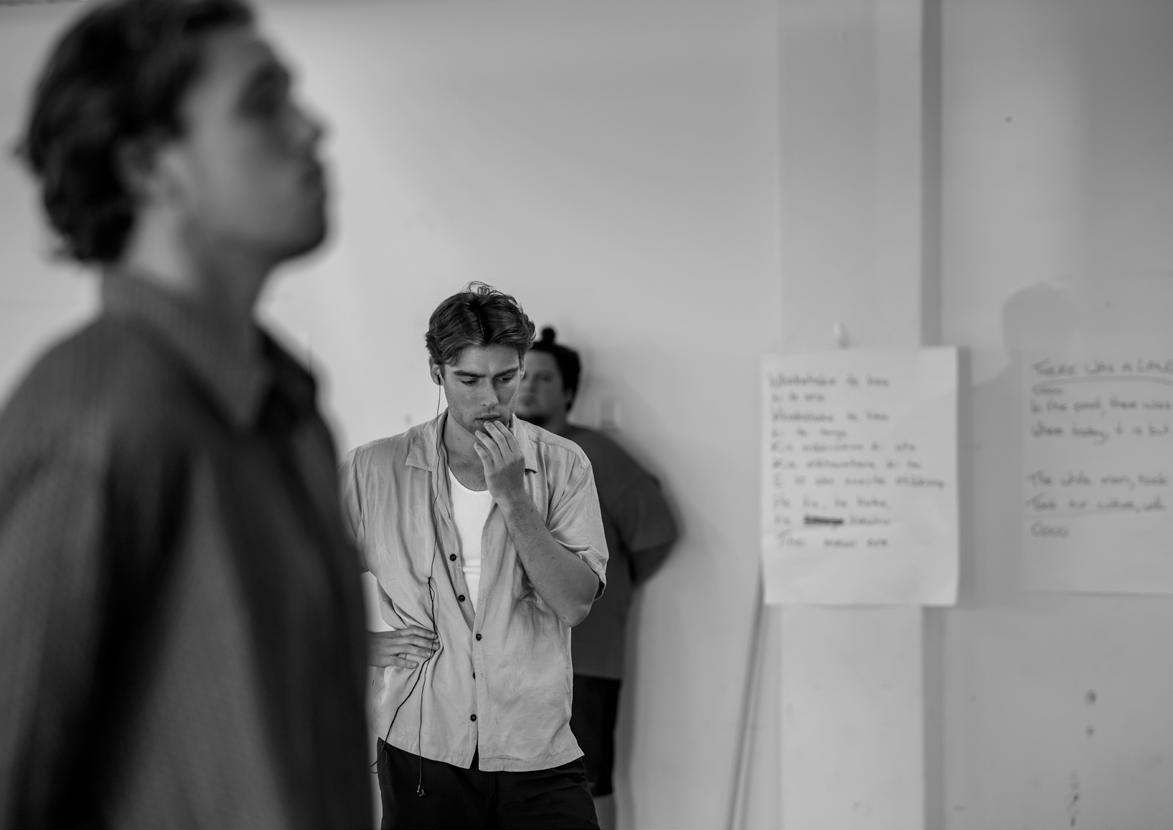
“Verbatim is not written in a traditional sense… but is… conceived, collected and collated.”
14 15
Australian playwright Campion Decent
Author
of the verbatim plays Embers and
The Campaign
VERBATIM THEATRE INTERNATIONALLY
Here are some well-known examples of verbatim plays, from the global stage:
was made into a film starring Olivia Colman and Tom Hardy.
VERBATIM THEATRE IN AOTEAROA-NEW ZEALAND
into the life events that have shaped them as leaders.
Are You Now or Have You Ever Been: The
Investigations
of Show
Business by the Un-American Activities Committee by Eric Bentley was built on testimonies delivered during the trials led by Joseph McCarthy in the US in the 1950s. It was the first notable piece of verbatim theatre, premiering in 1974.
The Laramie Project by Moises Kaufman and Tectonic Theater Project saw the writer/director and a team of actors travel to Laramie, Wyoming to interview inhabitants of a small town about the 1998 murder of gay student Matthew Shepard. The murder was denounced as a hate crime and brought attention to the lack of hate crime laws in various states, including Wyoming.
A State Affair premiered in 2000 and was about a housing estate in the UK devastated by a heroin epidemic. The playwright behind that piece, Robin Soans, also created Talking to Terrorists, based on interviews with former terrorists, victims, and politicians.
London Road is a verbatim musical about the murders of five women in Ipswich. Creators Alecky Blythe and Adam Cork have musicalised all the vocal patterns of the interview subjects, creating a musical mosaic of lives lived and stories told. It
The Permanent Way by David Hare looked at the 1990s privatisation of Britain’s railways, building its narrative from the four major train crashes that followed. Jessica Blank and Erik Jensen’s The Exonerated depicted wrongly convicted survivors of death row.
Aotearoa has also made a significant contribution to the form, particularly with the pioneering work of local actor, writer, and director Miranda Harcourt. Miranda studied drama therapy in London in the late 1980s and began to deploy her work in prisons on her return to New Zealand. The result of that work, Verbatim, co-written with William Brandt, is based on over forty interviews with families of imprisoned murderers, families of victims and with the offenders themselves.

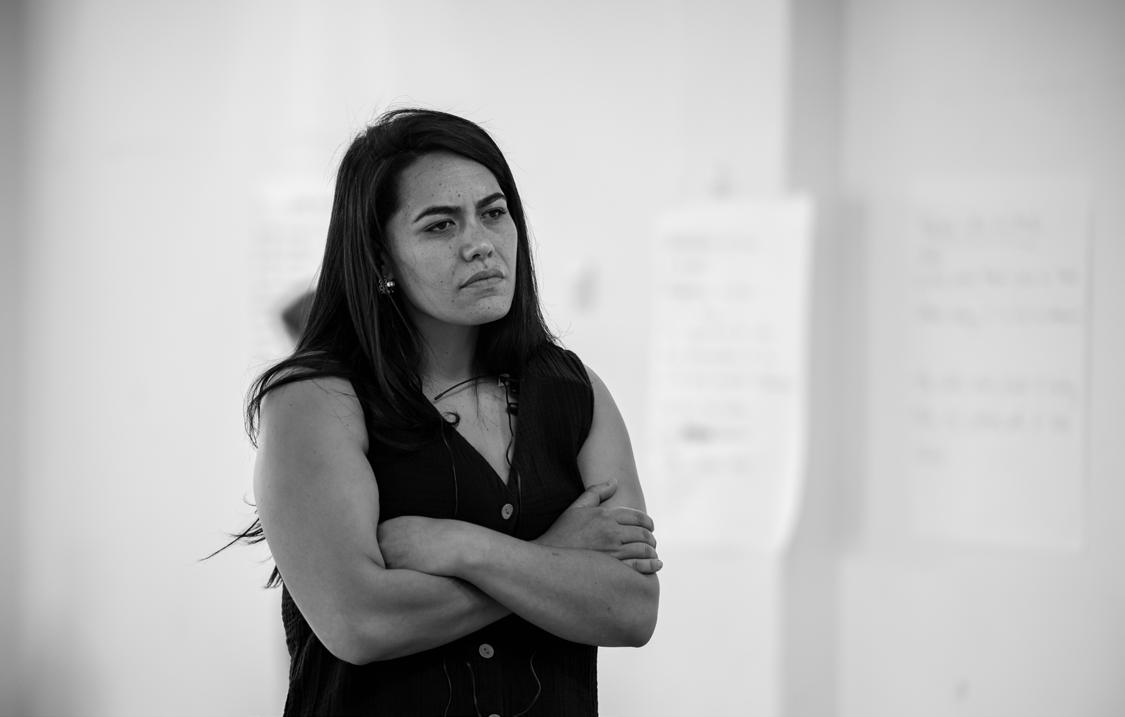

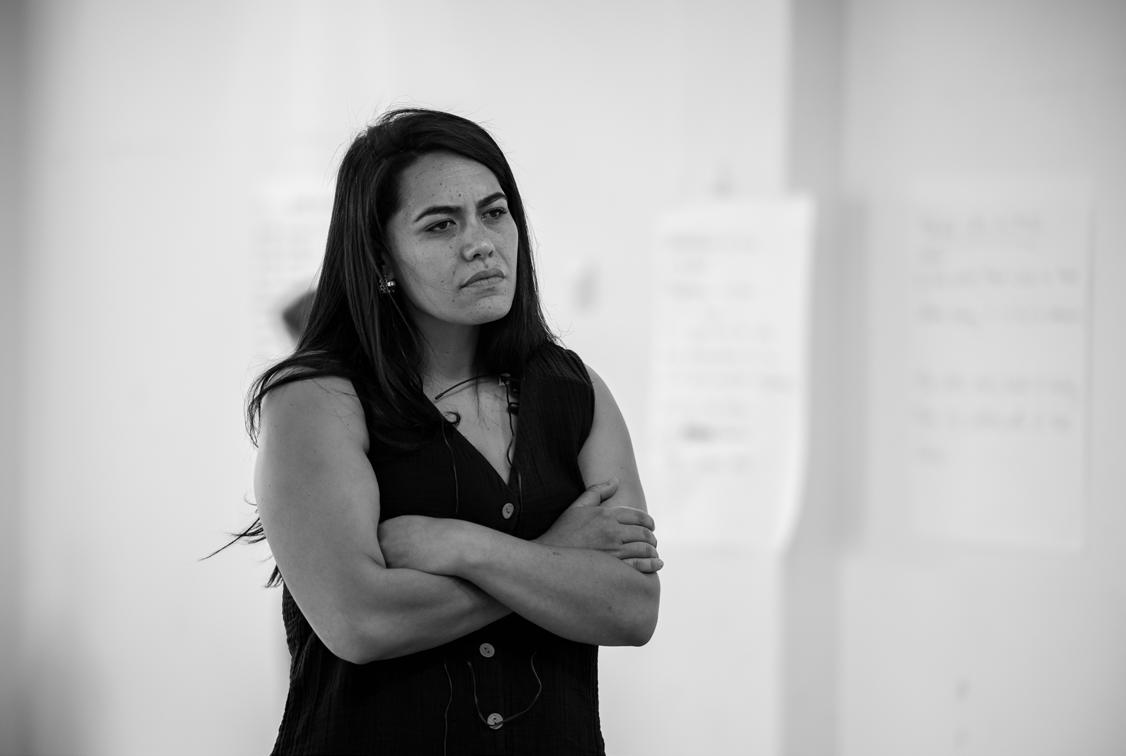



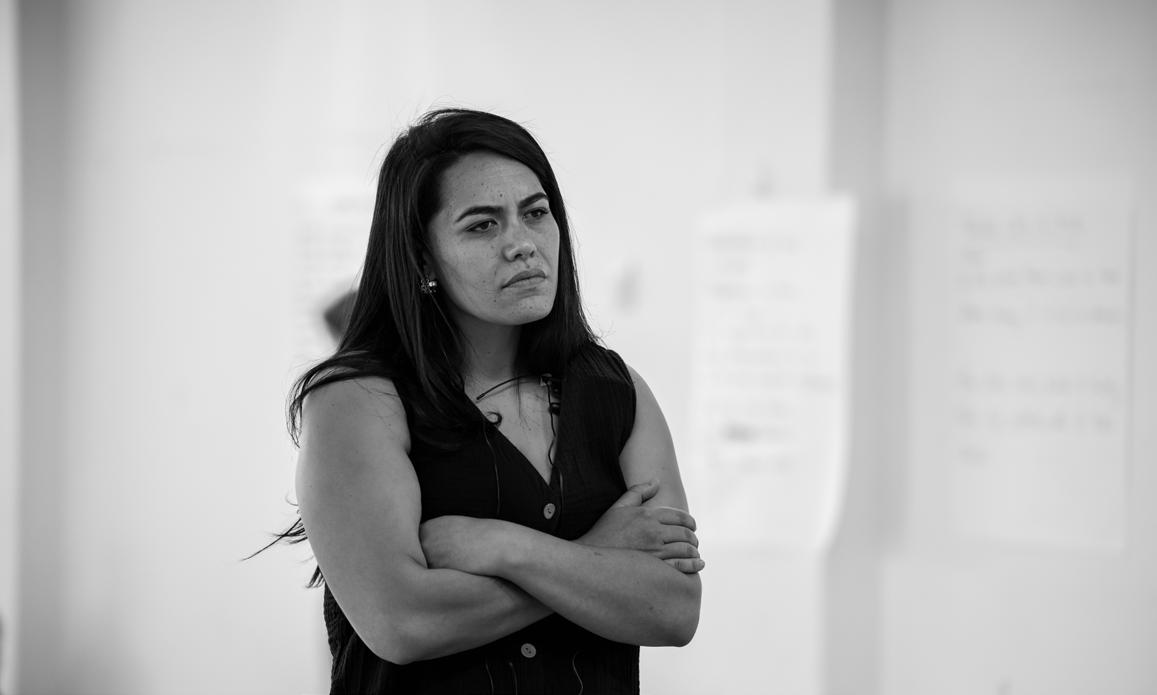


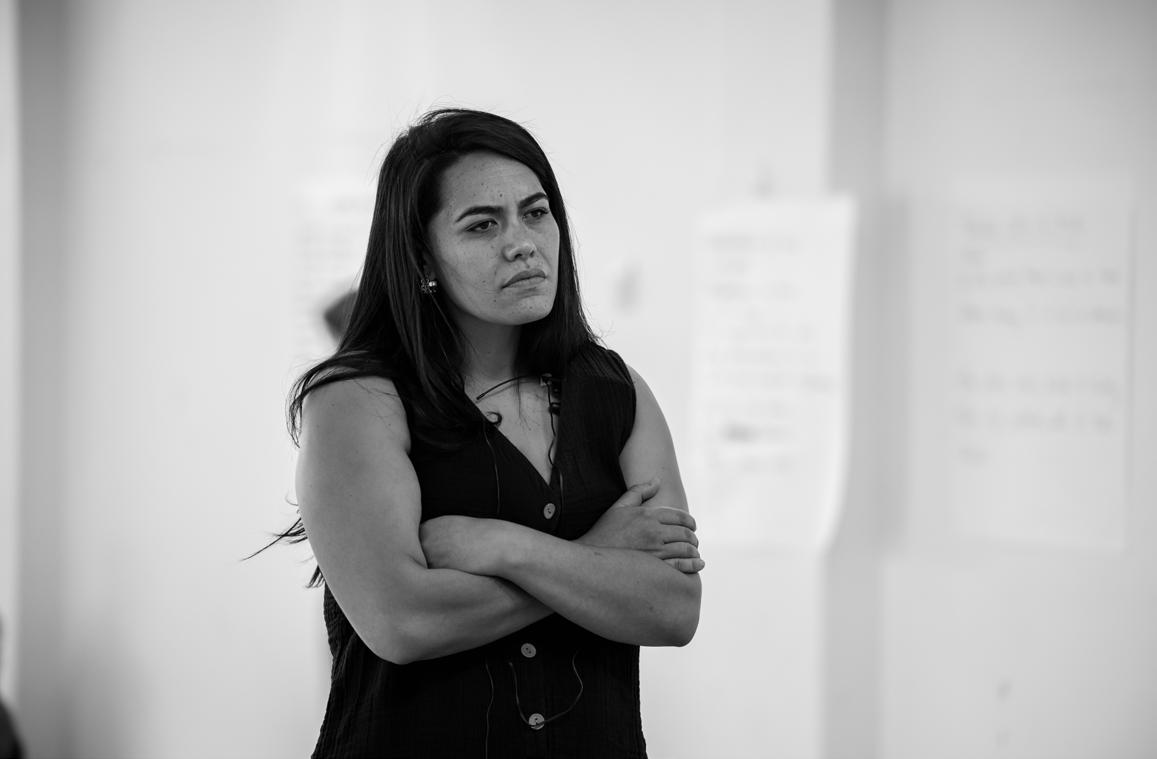

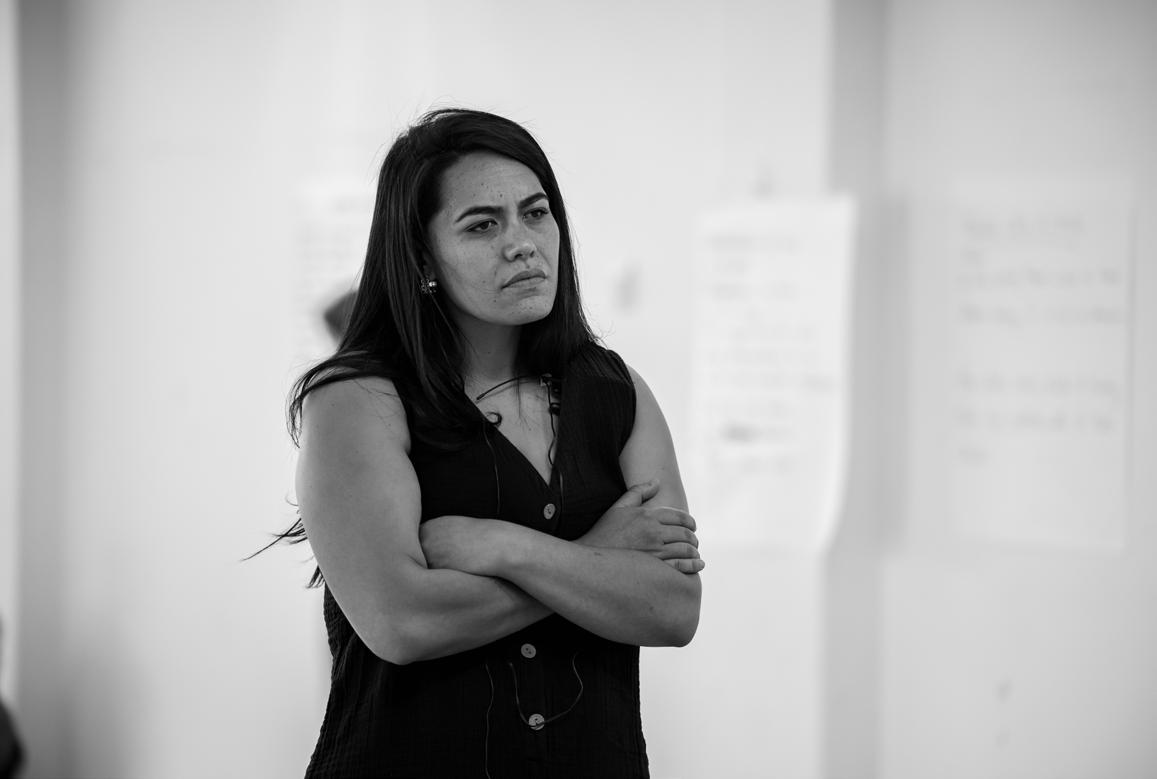

Widely studied and performed, Verbatim has been presented in prisons across New Zealand, initially to the interview subjects themselves. It is a story of how and why the murderers have committed their crimes and exposes some of New Zealand’s most hardened criminals. Miranda went on to create Portraits with Stuart McKenzie, which casts light on the nature of family on both sides of the rape and murder of a teenage girl in a small community. In April 2021, Miranda and Stuart will again return to the form with Transmission. Drawn from interviews with Prime Minister Jacinda Ardern, Finance Minister Grant Robertson and leading epidemiologist Michael Baker, it zeroes in on last year’s decision to lock down New Zealand in response to COVID-19 and its targeted elimination. It is a behind-the-scenes glimpse into how these people were thinking and feeling at the time - and
Other examples of verbatim theatre in New Zealand include:
The Contours of Heaven by Anya Chaya Scotney, Puti Lancaster and Marama Beamish. Led by the question “What does it take to determine who you could be”, the piece gives a platform to six young people from Te Matau a Māui, the Hawke’s Bay. It toured to New York in early 2020. Weave by Kate McGill. Kate studied with Tectonic Theater Project in New York while on secondment from Toi Whakaari: New Zealand Drama School. With this work, she gave voice to ordinary, working class New Zealanders.
The Keys are in the Margarine was created by Cindy Diver, Susie Lawless and Stuart Young in Dunedin, and later toured nationally. Using received verbatim technique, it sheds light on the realities of living with, or being affected by, dementia.
Fallout by Bronwyn Elsmore captured the sinking of the Rainbow Warrior in 1985. The bombing of the Greenpeace ship by the French Government is one of the cornerstone events in recent Aotearoa history and the play was created using transcripts with real-life subjects, media interviews and the resulting court case.
Groundswell by Elizabeth O’Connor is created from the words of survivors present in Christchurch during the 2011 earthquakes.
16 17
Kōrero with the director
During rehearsals, we asked Katie Wolfe to share about her process, the merits of Verbatim theatre and how the script has changed since the global pandemic.
What was your first encounter with the story?
I first heard about The Haka Party Incident when I read Ranginui Walker’s Ka Whawhai Tonu Matou, which has one page on it. I was drawn to the story because it seemed very clear to me that this was a moment of violence between Ngā Iwi Māori me Ngā Iwi Pākehā - and that was a significant thing. I then asked people about it, and everyone I spoke to had never heard about it. I quickly learnt that this was a piece of New Zealand history that had been forgotten. It is also written about in Ranginui Walker’s biography, but other than that you won’t find it easily as it was very much sidelined in the era of the late 1970s, early 80s.
You went on a big fact-finding mission. How difficult was it to access all the info about it? Because there was no resource out there or original sources, it was a matter of reaching out to the people who were there on the day and getting them to tell their story. That took two and a half years to get people to the table. I discovered that it was something that [most] people didn’t want to remember. So, there was a process to get people to come and talk about it. I decided very early on not to include any media reports of the time. That was easy to access, but media back then was horrendously racist, institutionally racist, so I decided that they didn’t need any more oxygen, and I left those to the side.
How did you go about interviewing the people involved?
The very first interviews happened in 2011. Those were just audio interviews and all those people I re-interviewed again. The process
of filming people (because all the interviews had been filmed) is always a process: meeting people, establishing a relationship. Sometimes they would agree to be recorded first. Then later, because of the sensitivity of the Kaupapa, they would agree to come back to be filmed. So, there were a few people who were interviewed three times.
Have you made any specific editorial choices to focus the story for the audience?
Often on my mind when I’ve been editing is the word balance. I haven’t really been interested in any voices that are personalising the racism. This is an exploration of institutional racism. It’s been our job to put that canvas in front of people - what institutional racism actually looks like. I am also very aware that the context of the story is 1979. New Zealand was a different place back then and it’s quite hard to convey the banality of the racism back then because it’s very shocking now. So, it’s important to contextualise that. Our job is to present the truth - which is verbatim from the people who were there. It’s going to be really interesting to see how it lands.
Why do you reckon verbatim is the best mechanism to tell this story? What does it achieve that a scripted play can’t?
I love verbatim. I’m sure there is a scripted drama in there, but verbatim is so compelling. You’ve got what people were really saying, what people were really thinking. Truth is often more astonishing and stranger than fiction, which is what draws me to it.
You’ve been working on this project since 2011. How has your personal connection to the story changed over that time?
I’ve been on an interesting journey where I have felt the weight of the story that I am telling, in terms of having to confront the issues around racism. You can try to be objective, but under those stories is a huge amount of pain. I also became very intrigued by how the racial landscape in New Zealand has changed. So, I can be a very objective and enthusiastic researcher of this story, but it can very quickly turn sometimes where I can feel the weight of this storyin terms of its’ taumaha - of its heavy themes.
18 19
Why does this story need to be told now?
In many ways what I have learnt from world events of late, is that creativity is the product of time and place. I think that the world is an evolving place, and the discussions around how we talk about race are probably quite useful right now.
Who are you wanting to connect with this piece?
I’d really like a new audience to come to the theatre. I want to find an audience who usually don’t like going to the theatre and hearing political things - I’d love that audience to come. Because at the end of the day, we make entertainment, and it is going to be a really entertaining piece of theatre.
You did a test drive of your script back in 2017, in Auckland Theatre Company's The Navigators project, and the play was originally programmed for the ATC 2020 season. We’ve since navigated through multiple postponements and lockdowns and we are in quite a different world now. How has the script developed over time? Hugely! There are just two pieces that are from The Navigators
season. They were the best parts of that initial production. They were the lead in how this next draft has been written.
The really big inclusion came only this year. If I’d done the play before the COVID shutdown, this wouldn’t be in it. (Again, this idea that creativity lives in time and place!) There is [now] a really strong element of Kapa Haka performance. We are tracing the whakapapa of the haka that was performed by the engineers in 1979. Where do those haka actually come from?
We’ve also included the beautiful protest songs of the 1970s, the music of that time. There was a gathering after the quad meeting. Quite shyly, the group didn’t know how to finish the evening, so they all sang John Lennon’s Imagine… which I thought was really great. That’s in the production.
The Navigators season featured projection, but this one has eliminated it [almost] entirely. What’s been your approach to designing the production?
I’ve already done two shows at the ASB Waterfront Theatre where I’ve had extensive use of projection. I do have access to video imagery, but I really wanted audio to become the design focus.
It’s sound and space that provides the focus on this vast stage. We are using every single inch of the ASB Waterfront Theatre stage. That’s the focus of the production.
You mentioned haka before. What purpose do they serve in the fabric of the production? We perform four different historical haka, some of them many times over as the play progresses through time. We also have this one haka that has been written for the show, He Taua. It has elements of all the haka that are mentioned in the play - and it concludes the play. It’s been written by my son, Nīkau Balme. He’s an absolute lover of kapa haka and a kapa haka performer. He has extreme confidence in te reo Māori and has been able to help me immensely in that facet of the play.
The structure of the play does take a nod towards the Whare Tapere, in which the kapa haka group have their items that they perform. The cast/kapa enter and perform a whakaeke and then their last item is the whakawātea and they then leave the atamira. Our original haka He Taua is the whakawātea.
What unique challenges do you have working with the actors?
Received Verbatim is an incredibly technical exercise and hugely challenging. I feel an enormous debt to the actors right now - what they have learnt is astonishing. The trick with verbatim is that they have this incredibly intimate, intricate, and nuanced performance that is electronically being fed into their ears that they then have to take out and throw it to the audience. It’s a very tricky thing. Yeah, it is really difficult!
You can listen to Katie talk about the production on Radio NZ National here: www.rnz.co.nz/national/ programmes/standing-room-only/ audio/2018785466/the-haka-partyincident-is-now-a-play
Watch Katie and some of the cast and creatives talking about the show on TVNZ Marae, here: www.tvnz. co.nz/shows/marae/episodes/ s2021-e5 or here: www.facebook. com/watch/?v=486438799155053
20 21
Kōrero with the kapa/cast
During rehearsals we asked the actors to share their processes, including the joys and challenges of verbatim, discovering forgotten stories and playing real people.
In this piece you integrate received verbatim, haka, waiata, and perform as multiple characters. What are the unique challenges? And what have you enjoyed the most?
Richard: The show is a beast. It is the biggest work-out of any show I have ever been involved in. It is a lot to get out and hold space for both the audience and the people we are playing. I have enjoyed seeing where my limits are as an actor, and how far I can push myself.
Lauren: There is a lot to wrap your head around and a big challenge has been staying focused in the
scenes we are in and not thinking ahead to what's next. I've really enjoyed learning about verbatim and how much that form can structure a performance, and because this has been integrated with haka and singing, we have moments of physical freedom from the constraints that verbatim can sometimes give you.
Jarred: I don't speak te reo Māori, nor do I have experience in kapa haka, so that aspect of the show has been physically, vocally, and cognitively demanding, but rewarding once it has been (somewhat) conquered.
Patrick: Differentiating characters through voice and physicality
sometimes in the same scene presented its challenges. When we come together as the kapa to perform waiata and haka - that has been my favourite part of the process.
Aidan: The challenge is learning the whole mixture deeply so that you feel freedom to go in and out of kapa to character to singer. At first, I felt worried about being judged for doing the engineering [mock] haka, but I realised that it only gives more meaning to me doing the proper haka with full energy, intensity, and focus. We cannot un-write that these improper haka were performed, but we can do the haka properly.
You are often performing the Received Verbatim form with a headset playing audio tracks from the real people involved in your ear. What challenges and discoveries have you
You can hear Neenah Dekkers-Reihana talking about the play here on Radio Waatea:
www.waateanews.com/ waateanews/x_news/MjY5MTg/Truewords-told-on-Haka-Party-Incident
made about working with Received Verbatim?
Richard: Received Verbatim is quite a tricky thing to do. In most live performances you can feel an audience and respond to a reaction or a laugh before moving on but with Received Verbatim, because you are constantly trying to stay accurate on the dialogue and voice quality through one ear, you often find yourself desensitised to the live response of an audience. You can't ride a laugh because the words being fed into your earpiece don’t stop. They keep going.
Lauren: I've used the verbatim as a jumping off point. It is astounding how much you can learn about someone simply by listening to their voice, the pace at which they speak and their sentence structure. The voice is also a great tool to get to the essence of a character, so rather than mimic exactly how these people sound I used their voices to build the theatrical version of them I wanted to portray.
22 23
That means that in performance I can use the Received Verbatim as a guide to keep me on track, rather than as a strict rulebook from which I create a carbon copy.
Jarred: [This is] my first time acting in the Received Verbatim form which I've found a difficult skill to master. Typically, as a performer you collaborate with your director and fellow actors and explore different ways of bringing a scene to life. Acting alongside the audio recordings means we are working to much tighter constraints in terms of how the text is delivered. But, as rehearsals have progressed, and my confidence and familiarity with the recordings has grown, I've felt more freedom to build upon the original account and embellish certain details or phrases.
Aidan: It is a real person behind the words on paper, their actual voice in your ear. So, while it’s daunting at first, Received Verbatim is our tool to do these humans justice, to tell the true story.
How do you navigate character interpretation? Do you at all?
Patrick: All the resources Katie provided really helped. I have just been listening to their voices more than anything. Trying not to over complicate my understanding of what they are saying and why because at the end of the day it is their story in their own words and I am just a part of the waka bringing it in to shore.
Richard: Katie has been monumental to the process of helping us find both the essence and our own version of these people we are representing who all have an immense amount of mana. Some of them are still alive today which has added pressure. I have spent most of my time on vocal quality as two of my characters are well known, so I have been working quite hard there.

25
How do you integrate an emotional life into the character?
Aidan: External emotion is very thin on the engineers, so it’s really about picking out fine details [from the recordings], where they sound most confident or where they stumble on words and sound uncomfortable.
Lauren: I'm portraying some of the lesser-known characters in the story, so there is less archival footage for me to draw from. In some ways this has given me more freedom of interpretation and creative license. Also, most of the recordings are of these women today, but I am portraying them in their 20s, so this has opened up a whole range of physical and emotional journeys to explore. It's been important to do a lot of work outside of the text and to research the emotional experiences and lessons these people went through to get to where they are now.
What unique physical attributes are you focussing on, if any?
Aidan: Giving each character a certain posture that relates to the energy they gave out in the interviews, finding out where in their body they might physically lead from, as well as the gestures and vocal patterns. Doing this to its extreme lets me see physical impulses that the person might have, then if I tuck that energy back into the body and try to perform the person with as much stillness as possible it becomes clearer where the body wants to move and where the voice wants to come from.
Jarred: I’ve been trying to let the sound of their voices guide my physical choices - the qualities of one's speaking voice can also be suggestive of their physicality.
What experience/learnings have you had from speaking the testimony of the people involved?
Patrick: That the mamae is still present today.
Lauren: It highlights where people's bias’s sit, and how accounts from the same day can feel like totally different stories. It's also pretty harrowing to hear the testimonies from the prison cells the day after the incident. Such violent and brutal acts explained in such a clinical way almost makes the weight of them more significant.
Aidan: This feeling of deeply understanding a person and their upbringing, what life was like for them and how that landed them into this moment. And the choice that moment gave them. I have an absolute respect for the Māori culture and a craving for a deeper understanding of my own culture and identity, I don’t want to be unaware anymore.
Are there any of the stories that really hit home for you?
Richard: 100% of these stories have hit home for me. Growing up in Hastings/ Flaxmere was rough, and a lot of what these great people speak to uncovers the reasons why. There is still racism toward people who aren’t white in Aotearoa. Hopefully, this show can be a great catalyst to open the communication lines between both cultures and work toward a more harmonious way of living.
Jarred: I think the story has been revelatory for me. The event is so much more than the brief altercation that occurred on 1 May 1979. It is a clear, historic example of the way in which institutionalised and casual racism has existed in New Zealand, and much of what is said by people in the play aligns with what is still being said in 2021. In that sense, the sentiment at the core of The Haka Party Incident is timeless.
26 27
Lauren: I knew very little about the haka party incident before I started work on this and it really has been an eye-opening journey. Not only learning about this incident, but also delving deeper into New Zealand history and race relations in this country overall.
Aidan: Where I went to university there was an annual event called ‘ladies’ day’, where male students would put on dresses and wigs, get very drunk and party till they passed out. Another party was held for second year male students dressed only in their undies with body paint and gas canisters filled with alcohol, this was called the ‘aboriginal party’. When I heard about the haka party incident it took me straight back to university days and the ignorant attitude I used to wear, and I guess am still working on. I knew these events were not good and I never took part, but I also never challenged my mates who did.
Why is this piece so necessary now?
Richard: For me to be in my 30’s and not even know this story existed just goes to show how little we know about the racist footprint in Aotearoa.
This piece encompasses so much hurt, which can be rectified if we can just start talking about racism. Not in a way to blame. But in a way to understand to move forward together as one people.
Lauren: It’s necessary now because these issues still exist in Aotearoa. To quote Mitzi Nairn; "Racism rolls on whether you're enthusiastic, like a bigot, or working against it ... and we're all adapted to living in a racist society." It's by talking about events like this that we can see how far we have come, and how far we still have to go.
Jarred: Many of the words spoken, particularly by members of He Taua will be very confronting for the audience, particularly Pākehā, and this show provides a platform for a lot of forgotten testimony.
Patrick: It is a part of Aotearoa’s history that not many people know. The comparison of perspectives from the time it happened and today.
Aidan: People are unaware of the necessity to acknowledge the living cultures around them. This play is vital to readjust these ignorant attitudes into a thinking of balance, where every culture has its place in Aotearoa.

29
Ngā Māngai
Voices of Documentary
Hilda Hilda Harawira, He Taua and Student University of Auckland
Miriama Miriama Rauhihi-Ness, He Taua
Zena Zena Tamanui, He Taua
Ronnie Veronica Leef, He Taua
Mary Mary Povey, He Taua
Georgina Georgina Walker-Grace, He Taua
Wiki Wiki Tawhara, He Taua
Ben Ben Dalton, He Taua
Hone Hone Harawira, He Taua
James James Pasene , He Taua
Brian Brian Lepou, He Taua
Len Len Nukunuku, He Taua
Andrew Andrew Leef, He Taua
Joseph Joseph Leef, He Taua
Tigilau Tingilau Ness, Polynesian Panthers
Ian Ian Bishop, Engineering Student UOA
Simon Simon Faire, Engineering Student UOA
Brent Brent Meeken, Engineering Student UOA
Simon Simon Woodward, Engineering Student UOA
Andrew Andrew Stewart, Engineering Student UOA
Te Rangi Te Rangi Hīroa, kaitito/composer ‘Ākarana’ (1924)
Eruera Eruera Stirling, expert witness for the defence ‘Police vs Dalton and Others’
Kīngi Sir Kīngi Īhaka, court translator for Eruera Stirling
Des Des Mathen, Engineering Student UOA (1955)
Barry Barry Davidson, Engineering Student UOA (1967)
Janet Janet Roth, President of University of Auckland Student Association
Mitzi Mitzi Nairn, Auckland Committee on Racism and Discrimination
Anne Anne Salmond, Lecturer in Social Anthropology and Māori Studies UOA
Kathy Kathy McRae, Quad Forum Attendee, Student UOA
Karen Karen Bishop, Quad Forum Attendee, Student UOA
David David Merrit, Craccum Editor
Alan Alan Blackburn, Auckland Race Relations Office
Vapi Vapnierka Kupenga, lawyer for defence ‘Police vs Dalton and Others’
Sian Sian Elias, lawyer for defence ‘Police vs Dalton and Others’
David David Morris, lawyer for prosecution ‘Police vs Dalton and Others’
Richard Richard Harman, journalist for Eye Witness News
Police A Anonymous, on-duty police officer Auckland Central May 1st 1979
Police B Anonymous, on-duty police officer Auckland Central May 1st 1979
30 31
Design
At the design presentation on the first day of rehearsals the creative team outline their intentions for the set, costume, sound, lighting and haka in the play.
Set Design: John Verryt
John Verryt intends to draw the stage and the auditorium together to ‘’eliminate the sense of walking into the theatre” by cladding the stage walls with the same material lining the auditorium walls. Katie Wolfe adds that she wants to emphasise that the audience is looking at itself, saying “the play is you.”

John’s design uses the full depth and width of the ASB Waterfront Theatre stage. There are no wings as such, but a small changing area off the stage floor that the actors - who are on stage throughout the piece - can use when necessary.
John is exploring the maximum
volume of stage space, “I want to pull the audience energy into the void to support the actors. Usually, I am using the set elements to push the performers energy out from the stage towards the audience. Let's see what happens!”
Other elements include the grid pattern on the stage floor which references the University of Auckland quad and the picnic bench that is brought onstage during the quad meeting scene. The table can symbolise two parties coming to the table (a nod to the Treaty of Waitangi - te Tiriti o Waitangi).
33
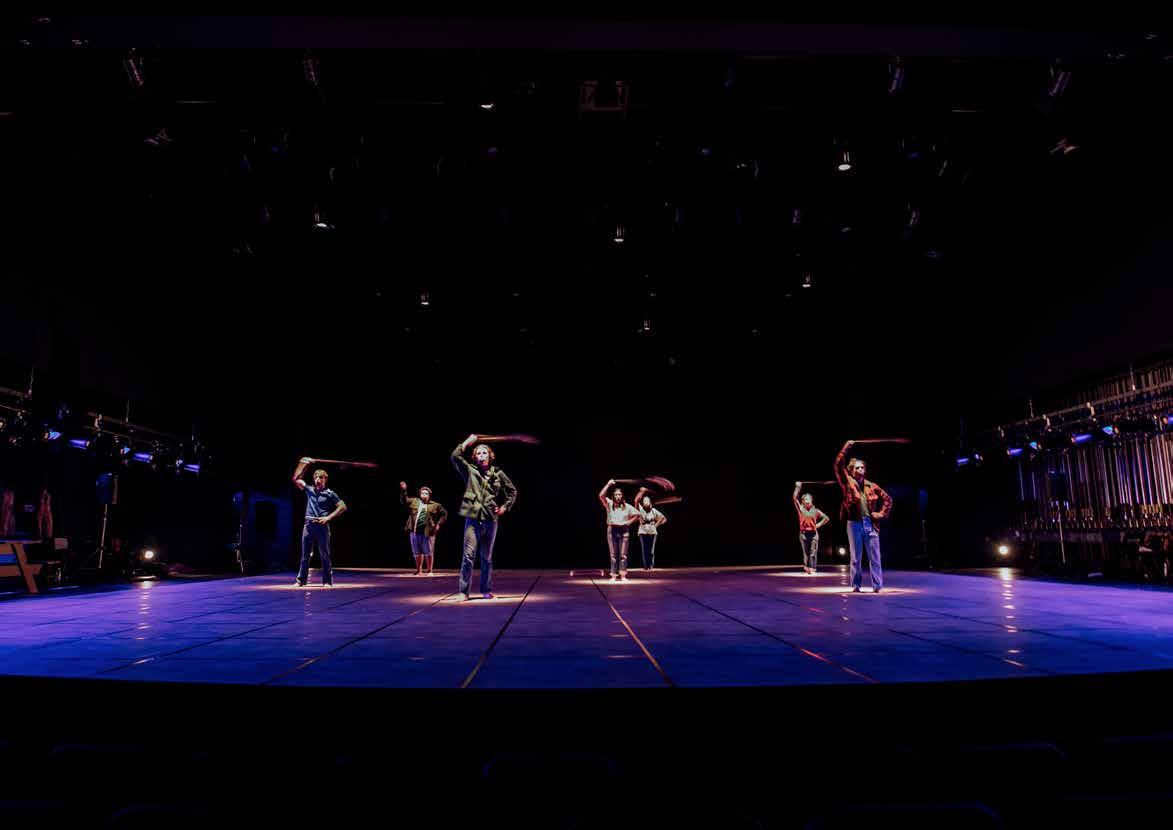
Costume Design: Alison Reid

Alison says the costume design will reflect the 1970s period when the incident took place.
Alison explains that in Aotearoa in the 1970s fashion brands were limited, there simply wasn’t the choice or access we have today. Bush shirts or Swanndris were worn on the farm and in the city - particularly amongst university students. Hence a decision to use Swanndris in various colours and denim jeans as a base costume for each actor. Jean brands were also limited in those days, the most common being Hard Yakka and Levis, so Alison has sourced vintage jeans in various shades of denim for the show.
Over the base costume actors wear different shoes to represent the many characters they portray. Shoes are also referenced in the script in relation to haka, with this note:
Another important aspect for
In accordance with tikanga (protocol) no shoes are worn when performing haka. However, there are instances where the haka is performed in an historical context and the words and actions are performed poorly and the performers wear shoes.
Alison is considering the costume the engineering students wore when performing their mock haka. She shows us archive images of engineering students in full grass skirts in the 1950s, then ratty grass skirts in the 1970s with offensive words and images drawn on their half-naked bodies. Taking these grass ‘hula’ skirts off the students was the aim of He Taua activists during the incident.
36 37
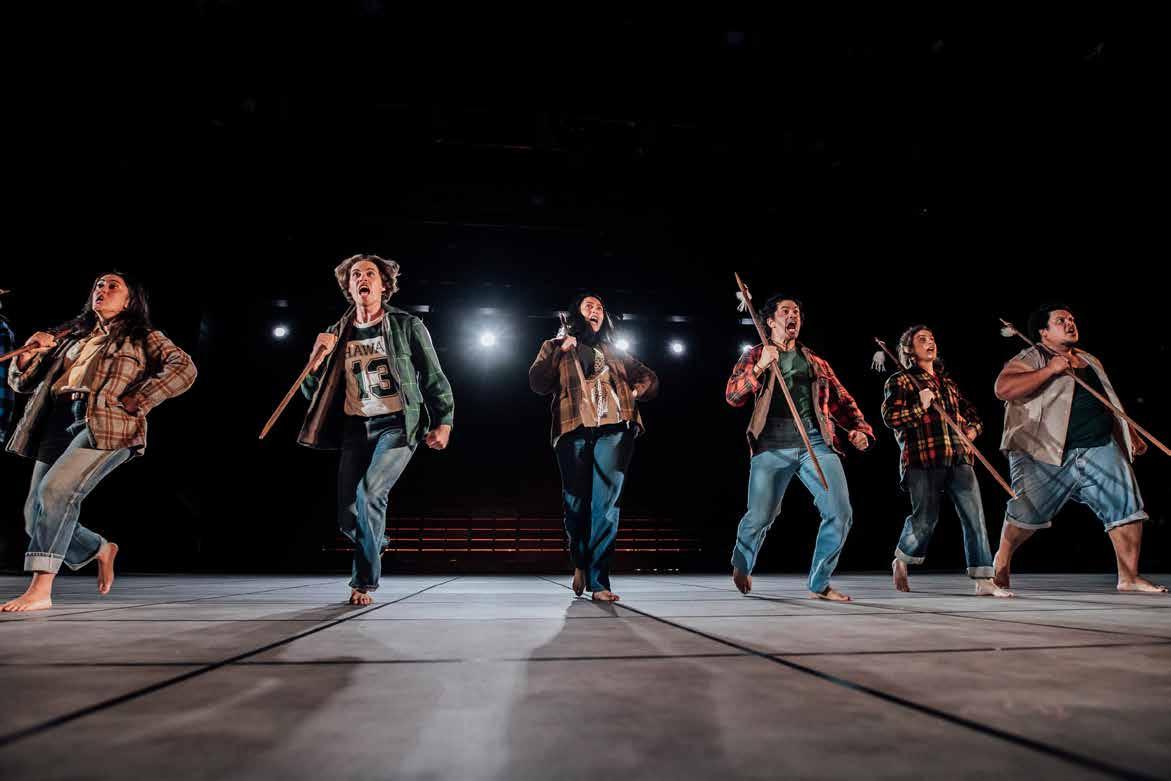
Sound Design: Kingsley Spargo
Sound Designer Kingsley refers to himself as the “verbatim guy’’.
He explains that during rehearsals he will be editing the recorded interviews so that the actors have the audio tracks of their people/characters to work with in the Received Verbatim process - where the actor wears a headset and microphone and ‘receives’ the voice of the person in their ears as they are saying the same text. Katie explains that each actor will find their own way to work with the Received Verbatim, some will say it simultaneously others will prefer to be a beat behind the speaker, etc.
Occasionally the cast will also perform Non-received Verbatim, which is like learning a script, but from a written transcript of an interview. Kingsley says that the demands of performing
verbatim means the production is quite technical. As the cast are mic’d the audience will hear the lightest whisper from stage and Kingsley explains that the audience will need to “settle into our sound bed and get used to sound coming from the speakers.” Actors cannot go off mic as this would be confusing for the audience. He is excited by minimalism of set and by the possibilities of the sound and music to transport the audience’s imagination. He will do some sound augmentation to create a juxtaposition of soundscapes, including recorded and live music and guitar and taonga pouro performed by the cast. Songs include waiata that have been mentioned in the research and John Lennon’s Imagine.

41
Lighting Design: Jo Kilgour
Jo explains that the lighting design is evolving with the blocking through rehearsal but that she will create pools of light in specific squares and areas of the floor grid. The 1x1m grid is mapped out on the rehearsal room floor and the rehearsal room is only 2m short of the ASB Waterfront Theatre stage length and depth.
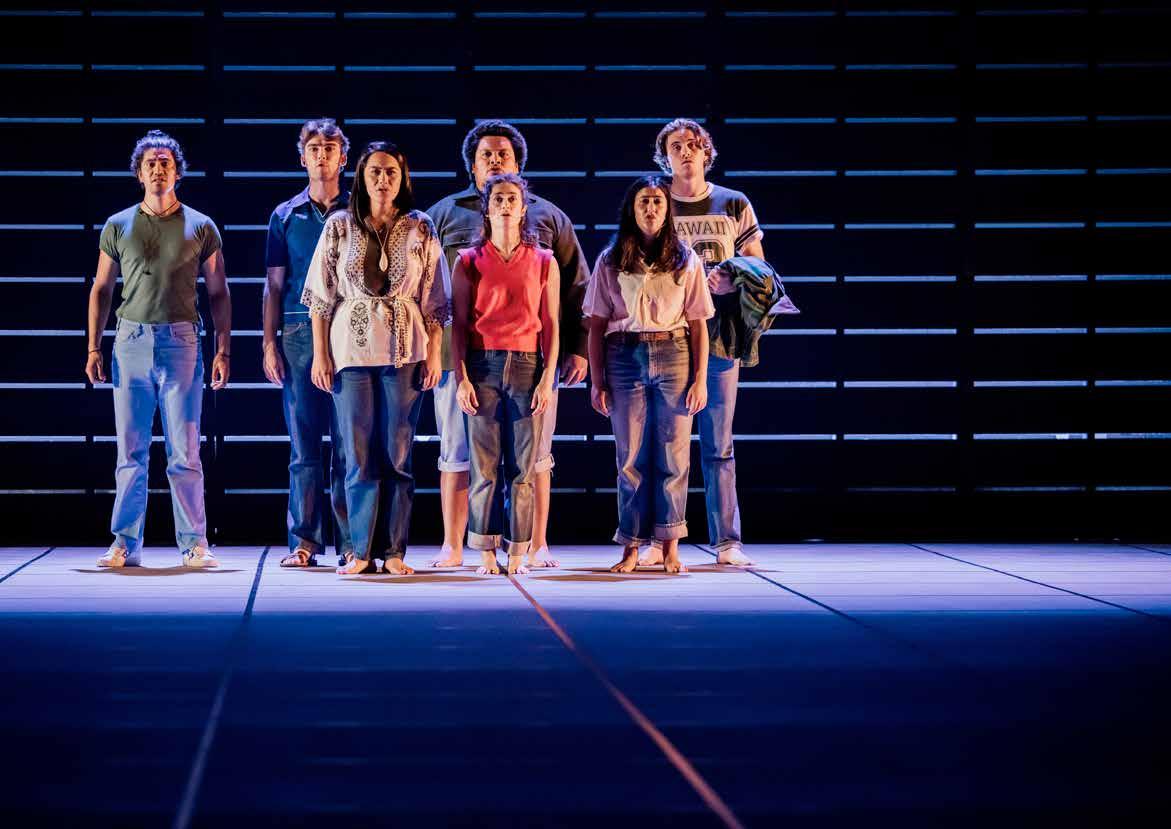
Jo says as part of the stripped back aesthetic lighting bars will be exposed and hung on lots of rafters and there will be side lighting.
There is an evolving discussion about AV which will include text on the back wall to show important words (kupu).
42 43
You can read more from Nikau Balme in these news articles here: www.stuff.co.nz/entertainment/ stage-and-theatre/300261547/thehaka-party-from-gang-rampage-tothe-history-books-and-now-theatre
Nīkau explains that the cast will learn four haka, including different versions from different eras, and including the mock haka of the engineering students. Katie adds “We will perform some of them many times over as the play progresses through time.”
See the following page for a list of all haka and waiata performed in the show.
 Kapa Haka: Nīkau Balme
Kapa Haka: Nīkau Balme
44 45
HAKA AND SONG
Tau Ka Tau
Traditional Waikato Haka
Ākarana
Auckland University College Haka by Te Rangi Hiroa (1924)
Akarana
The Ardmore Engineering School Haka, Private Collection, Des Mathen (1955)
A Ka Rana
Engineering Haka, Private Collection, Iain Neill (1979)
In the Past
Maranga Mai (Activist Theatre Group, 1979) Private Collection, Brian Potiki
Hey Māori People
Maranga Mai (Activist Theatre Group, 1979) Private Collection, Brian Potiki
Imagine
John Lennon (1971) Arrangement by Kingsley Spargo
We are We are The Engineers
The Ardmore Engineers Song
The Battle Hymn of the Republic
Lyrics by Julia Ward Howe (1862) Arrangement by Kingsley Spargo
Ka Mate
Composed by Ngāti Toa Rangatira Chief, Te Rauparaha
Me Hoki Whakamuri Kia Anga Whakamua
The University of Auckland Faculty of Engineering Haka by Tapeta Wehi (2019)
He Taua
Original haka written for The Haka Party Incident by Nīkau Balme (2021)
ĀKARANA
Auckland University College Haka
1924
Te Rangi Hiroa
Ākarana Hei
Tena i pakia
Tena i takahia
Ringaringa tōrona kei waho
mau tonu
Tau ka tau Hei
Tau ka tau Hei
Tau ka tau ki Ākarana
Whangaia mai ra!
nge, nge, nge, ara tu
Whangaia mai ra!
nge, nge, nge, ara tu, ara ta, ara tau
Ākarana ka riri!
Homai ra o kupu, o toa
Kia wetewetea, kia tukitukia
Ākarana Hi
Ākarana Hei
Ākarana Hi, Hei, Ha
Auckland - Here
Now for the beat
Now for the stamp
Hands stretched out
And kept there
We are here, we are here - Hei
They are here, They are here - Hei
They have come to see Auckland
What can they say?
Nothing, nothing, nothing at all
What can they do?
Nothing, nothing, nothing
Absolutely nothing at all
Auckland is arrayed for battle!
Come with your wise men
Come with your best
That they may be confounded
That they may bewildered
Auckland Hi
Auckland Hei
Auckland Hi, Hei, Ha
46 47
HE TAUA
Original haka written for The Haka Party Incident by Nīkau Balme 2021
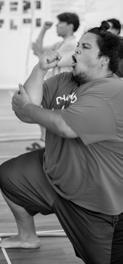
He Taua
Ki te mura o te ahi
He Taua
Ki te tohi o Tūmatauenga
He Taua
Ki te tākiritanga o te ata
ki runga Tāmaki e tū nei
E te tī, e te tā
Hi ha
E te tā, e te tī
Haramai ra, haramai ra, haramai ra
Tēnei ko Tāmaki Herehere
Tāmaki Ararau

Kua whakawhenua te tangata
Kua whakamana te Reo me ōna tikanga
Hei te pō, hei te ao
Te whakamāori e
He kaikiri, he Taniwha e
Hōmai ra o kupu o toa kia wetewetea
Wetewetea, wetewetea
Whakamanatia te tangata e
Ka Mate
Ka ora
Ka Mate
Ka ora
Ka mate, ka mate
Ka ora ai te ao Māori
I te tinana, hinengaro, wairua
Ka ora e
Tau ka Tau Hi
Tau ka Tau Hi
Tau ka Tau Hi
Tau ka Tau Hi
Tau ka tau
He Taua!
Ko te iwi Māori e ngunguru nei
I au, au, aue ha
Aue hi
He Taua
Is to the heat of battle
He Taua
Is blessed by the powers of man and warfare
He Taua
Is to the dawn breaking upon Auckland, arrayed for battle
To the many the masses
To all walks of life
Come, come upon Auckland as one, Auckland of plenty
Auckland who has grounded people’s belief in their land
Who has empowered Te Reo Māori and its customs

Day and night eternally
Māori powers onwards
To the monster known as racism
Give it here so it can be shredded
Ripped apart into nothing at all
To empower the people onwards again
There is death
And there is life
But despite the death
Māori culture will survive

Mentally, physically, and spiritually
It survives onwards
We are here
We are present
Here we stand
Stand as one
Stand as one, Arrayed for battle
A war party
He Taua
The Māori culture shakes the ground
And there it is
There!
48 49
Theatre form
The Haka Party Incident and the New Zealand Theatre Form
The play concerns a real event that took place at the University of Auckland in 1979 and uses verbatim accounts from many of the people involved in the event and its aftermath to tell a story from multiple perspectives.
The New Zealand theatre form is constantly evolving, and any play written by New Zealanders, about New Zealanders fits the description. However, it is generally accepted that a typical New Zealand play has one or more of the following distinguishing features:

• A concern with New Zealand history
• An exploration of the New Zealand identity and our sense of belonging
• Tikanga Māori vs the world of the Pakeha
• Displacement or loss
• Archetypical New Zealand characters such as rugby players or farmers
• Colloquial New Zealand language and icons
In The Haka Party Incident Katie Wolfe draws attention to an over looked yet pivotal moment from recent Aotearoa-New Zealand history when indigenous activists challenged institutional racism head on. By using verbatim interviews with people involved, the audience experiences the event from multiple perspectives. The way colonial attitudes towards Māori have changed (or remain the same) is further explored through the weaving of historic and modern haka into the performance. Wolfe also incorporates protest songs, testimony from the Human Rights Commission and transcripts from court hearings into the script, so that institutional and colloquial New Zealand language, English and te reo Māori are heard throughout the play.
Katie Wolfe was awarded the Adam NZ Play Award Runner Up and Best Play by a Māori Playwright for The Haka Party Incident at the Adam NZ Play Awards 2021.
50
Post-show activities
CHARACTER / VERBATIM
Describe a moment where a character was the focus in the performance. Think about and discuss
• The function of the character in that moment
body, movement, space, in their interactions with each other and as an ensemble (kapa).
• What effect did the performances of various mock haka have on you?
• How did that compare with the end haka - ‘He Taua’
REFLECTING ON THE PERFORMANCE
Group activity: Think about the performance you have seen and recall which characters, themes, scenes, or specific moments stood out for you. Brainstorm together, considering whether it is something you enjoyed, or something that confused you.
What do you remember most?
• Make a list of these characters, ideas or scenes that stood out for you.
• Recall how you responded in the moment to these characters or scenes. And did that reaction change after you had seen the play?
• How would you describe the play to a friend?
SPACE VS PLACE
This design used the space more than creating a realistic place.
• Sketch and annotate the set used in the performance
• Discuss different ways the full volume of the stage was used to memorable effect.
• How was that supported by lighting, sound, and other technologies?
• Describe the places the performance took us to; where did the scenes take place?
If you were designing and the director wanted a realistic look what might you need to consider as a designer?
What effect would having a realistic place (ie: the multiple locations in the story - University Quad, people’s flats, gymnasium, Queen Street) have on the play’s performance? You might discuss scene transitions/flow.
• Why that specific character was the focus in that moment
• Their position on stage
• The effect of the focus being drawn to the character
Thinking about this moment explain how the language (verbal/nonverbal) used by the actor highlights the intended purpose of the character in this moment in the performance. Consider:
• Use of drama techniques
• Use of verbatim
• Use of haka
• How the language developed the directorial concept
• Historical/social context of language
• Shock factor
Discuss the function of Haka within the play
• Moments of revelation
• Reinforcement of a key idea
NEW ZEALAND THEATRE FORM
Looking at the list of features of the New Zealand Theatre Form, how has each one been explored in The Haka Party Incident? Can you think of moments or characters from the play that fit into the descriptions of these features?
• How have the designers supported the setting of Auckland in the 1970s?
Explain the use of contrast as seen through the actor’s application of drama techniques - voice,
• Karen, a character from the University Quad meeting scene says, “We were never taught New Zealand history.” What is the playwright highlighting here, and how does it explore a feature of the New Zealand Theatre Form?
HAKA
52 53
ATC Creative Learning
encouraging acts of imagination
Curriculum links
ATC Creative Learning promotes and encourages teaching and participation in theatre and acts as a resource for secondary and tertiary educators. It is a comprehensive and innovative arts education programme designed to nurture young theatre practitioners and audiences.
Whether we are unpacking a play, creating a new work, or learning new skills we are encouraging habits of thinking that foster acts of imagination to take place.
ATC Creative Learning has direct contact with school
students throughout the greater Auckland region with a focus on delivering an exciting and popular programme that supports the Arts education of Auckland students and which focuses on curriculum development, literacy, and the Arts.
ATC Education activities relate directly to the PK, UC and CI strands of the NZ Curriculum from levels 5 to 8. They also have direct relevance to many of the NCEA achievement standards at all three levels.
All secondary school Drama students (Years 9 to 13) should be experiencing live theatre as a part of their course work, Understanding the Arts in Context. Curriculum levels 6, 7 and 8 (equivalent to years 11, 12 and 13) require the inclusion of New Zealand drama in their course of work.
The NCEA external examinations at each level (Level 1 - AS90011, Level 2 - AS91219, Level 3 - AS91518) require students to write about live theatre they have seen. Students who are able to experience fully produced, professional theatre are generally advantaged in answering these questions.
54 55




MYTHMAKERS – AGE OLD TALES TOLD LIVE
TWO, 2021 byAmber Curreen Directed by Whetu Silver AUCKLAND THEATRE COMPANY RECEIVES PRINCIPAL AND CORE FUNDING FROM: PRINCIPAL FUNDERS CORE FUNDER SUPPORTING PARTNER
Mahuika! TOURING SCHOOLS TERM
 BY KATIE WOLFE
BY KATIE WOLFE




























 Kapa Haka: Nīkau Balme
Kapa Haka: Nīkau Balme








